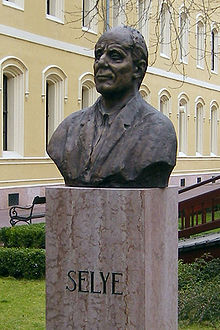Hans Selye

Hans Hugo Bruno Selye CC (János Selye [ ˈʃɛjɛ ]; born January 26, 1907 in Vienna , Austria ; † October 16, 1982 in Montreal , Québec ) was a Hungarian - Canadian physician , biochemist and hormone researcher .
In the 1930s he developed the fundamentals of the theory of stress and general adaptation syndrome or Selye syndrome. He is thus described as the "father of stress research".
Life
Hans Selye was born in Vienna as the only child of the Hungarian surgeon Hugo Selye and Maria Felicitas, nee Langbank. He grew up in Komárno and studied medicine in Prague , Paris and Rome from 1924 to 1929 . During this time he was already involved in organic chemistry, received his doctorate in 1931 and emigrated to Canada in 1934. In Montreal, he taught biochemistry at McGill University from 1933 .
Since the publication of his first scientific paper in 1936, Selye has written more than 1700 papers and 39 books on the subject of stress. "I gave all languages a new word - stress," said Selye when summarizing his life's work. At the time of his death (1982), his work had been cited in more than 362,000 academic papers and in countless stories in most languages and in all countries. He is still by far the most cited author on the subject in the world.
From 1945 to 1975 Selye was a university professor in Montreal and headed the Institute for Experimental Medicine and Surgery.
Selye had three doctorates (MD, Ph.D., D.Sc.) and 43 honorary degrees. He was a member of several dozen of the most renowned medical and scientific associations, including a member of the Leopoldina since 1976 . In 1976 he founded the International Institute for Stress . Selye has earned international respect not only for his scientific achievements, but also for his dedication to the practical implementation of his work. Two of his books "The Stress of Life" and "Stress Without Distress" were bestsellers (the latter book was even available in 17 languages).
He attended the Hungarian grammar school in Komárno . Today this school and the János Selye University in Komárno bear his name. In 2006 he was posthumously inducted into the Canadian Medical Hall of Fame .
Fonts (selection)
- The Physiology and Pathology of Exposure to STRESS . ACTA Medical Publishers, Montreal 1950
- Introduction to the theory of adaptation syndrome (German 1953)
- Stress dominates our life (German 1957)
- Electrolysis, Stress and Cardiac Necrosis (German 1959)
- Your heart needs tension - but it has to be processed , Hallwag Bern 1966
literature
- Barbara I. Tshisuaka: Selye, Hans. In: Werner E. Gerabek , Bernhard D. Haage, Gundolf Keil , Wolfgang Wegner (eds.): Enzyklopädie Medizingeschichte. De Gruyter, Berlin / New York 2005, ISBN 3-11-015714-4 , p. 1319.
- S. Szabo: Hans Selye and the development of the stress concept. Special references to gastroduodenal ulcerogenesis. In: Ann. NYAcad. Sc. Volume 851, 1998, pp. 19-27.
Web links
- Literature by and about Hans Selye in the catalog of the German National Library
- DS Goldstein, IJ. Kopin: Evolution of concepts of stress. In: Stress , 2007 Jun; 10 (2), pp. 109-120, PMID 17514579 . Clinical Neurocardiology Section, National Institute of Neurological Disorders and Stroke, Bethesda MD
- NN. Dygalo 2007 Stress concept in the centennial of Hans Selye . In: Usp Fiziol Nauk. , 2007 Oct-Dec, 38 (4), pp. 100-102, PMID 18064911 (article in Russia)
Individual evidence
- ↑ Current Biography Yearbook. Vol. 42 (1981), p. 367.
- ↑ Barbara I. Tshisuaka: Selye, Hans. 2005, p. 1319.
- ↑ Hans Selye: A Syndrome Produced by Diverse Nocuous Agents . In: Nature . Volume 138, July 4, 1936, p. 32.
- ↑ Member entry of Hans Selye at the German Academy of Natural Scientists Leopoldina , accessed on March 7, 2017.
| personal data | |
|---|---|
| SURNAME | Selye, Hans |
| ALTERNATIVE NAMES | Selye, Hans Hugo Bruno (full name); Selye, János (Hungarian form of name) |
| BRIEF DESCRIPTION | Austrian-Canadian medic |
| DATE OF BIRTH | January 26, 1907 |
| PLACE OF BIRTH | Vienna |
| DATE OF DEATH | October 16, 1982 |
| Place of death | Montreal |
